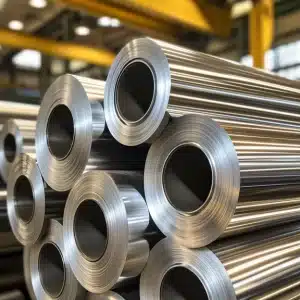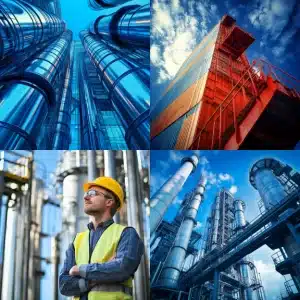
What ASME Defines as a Pressure Vessel | ASME BPVC Section VIII Guide

Pressure Vessel Description: Clear Definition, Types, and Standards
A pressure vessel description is a precise explanation of a container designed to safely hold gases or liquids at pressures significantly different from ambient conditions. These vessels must comply with rigorous safety standards, such as the ASME Boiler & Pressure Vessel Code (BPVC) Section VIII, which outlines the rules for construction. These guidelines ensure safety and reliability across industries—from energy to manufacturing.
In this guide, you’ll find:
A clear definition and working principle of pressure vessels.
A breakdown of common types like storage vessels, heat exchangers, reactors, and boilers.
Insights into applications and compliance requirements.
Industry best practices with educational links for deeper learning.
What Is a Pressure Vessel?
A pressure vessel is a robust container engineered to withstand internal or external pressures significantly higher or lower than atmospheric pressure. For helpful diagrams and technical details, see this comprehensive Wikipedia overview of pressure vessels. These vessels are essential in industrial systems for storing and handling fluids under pressure, classified by their function, construction, and regulatory requirements.
Types of Pressure Vessels
Storage Vessels are used in industries like petrochemical and food processing for safe, high-pressure containment. Learn more about different types of pressure vessels.
Shape-Based Variants include cost-effective but stress-intensive cylindrical designs and more uniform-stress spherical vessels. Explore these differences on our types guide.
Specialized Vessels such as heat exchangers, boilers, reactors, and distillation columns are explored thoroughly in our detailed vessel breakdown.
Why Pressure Vessel Description Matters
Accurate description and classification are essential—not only for clarity but for regulatory compliance. Misclassifying components like pipes as pressure vessels can lead to safety issues and non-compliance. Learn more from our article on pipes vs pressure vessels.
Standards and Compliance
Pressure vessels must meet stringent guidelines outlined in ASME BPVC Section VIII, covering divisions for various pressure categories. Additional design insights are available in our comprehensive design guide and this detailed engineering lecture. Internationally, European standards like the Pressure Equipment Directive align with similar safety principles.
How They Work: The Mechanics
Pressure vessels rely on sound engineering—stress analysis, proper wall thickness, rigidity, and non-destructive testing (such as ultrasonic or radiographic inspections). For a step-by-step breakdown, see Understanding Pressure Vessels: Design & Applications.
Concluding Insights (Elegantly Framed)
In Summary: Mastering Pressure Vessel Description
Ready to Talk?
Need expert help with pressure vessel design, ASME/PED compliance, or manufacturing? Check out our Contact page to connect with the Red River Team, your trusted partner in precision-engineered vessels.
Frequently Asked Questions
What defines a pressure vessel compared to a standard vessel?
A pressure vessel is constructed to sustain pressures vastly different from ambient—see more in the Wikipedia pressure vessel entry.
When should a pipe be classified as a pressure vessel?
If it operates under sustained or elevated pressure, it must meet vessel code requirements. Learn specifics in our pipes vs pressure vessels article.
What materials are commonly used for pressure vessels?
Common materials include carbon steel, stainless steel, and specialty alloys. Learn about material selection in our types of pressure vessels guide.
Key Takeaways
A pressure vessel description should thoroughly detail function, design, and compliance standards.
Common types include storage vessels, reactors, heat exchangers, and boilers.
Design choices (cylindrical vs spherical, thin vs thick walls) significantly affect stress management and safety.
Compliance with ASME BPVC Section VIII and equivalent international standards is non-negotiable.
Embedding trusted educational links improves authority and builds reader trust.
Related Blog Post
- Which theory of failure is used in designing pressure vessels and why?
- What is the typical safety factor for pressure vessels?
- What is the most serious hazard in pressure vessels?
- What is the ASME factor of a pressure vessel?
- What does ASME consider a pressure vessel?
- What are the criteria for a pressure vessel?
Solutions
In the realm of industrial solutions, Red River emerges as a pioneer, offering a diverse range of custom-engineered products and facilities. Among our specialties is the design and production of Custom/OEM Pressure Vessels, meticulously crafted to meet individual client requirements, ensuring performance under various pressure conditions. Our expertise extends to the domain of prefabrication, where Red River leads with distinction.
The company excels in creating prefabricated facilities, modules, and packages, reinforcing its stance as a forerunner in innovation and quality. This proficiency is further mirrored in their Modular Skids offering, where they provide an array of Modular Fabricated Skid Packages and Packaged equipment. Each piece is tailored to client specifications, underlining their commitment to delivering precision and excellence in every project they undertake.
Related Blog Post

Marine-Grade vs Standard Stainless Steel

Pros and Cons of Vertical Integration

How to Dry Desiccant Properly and Regain Its Effectiveness

Why Do Gas Turbines Need Fuel Water Separator Vessels, Red River

How Does a Gas Turbine Fuel Water Separator Vessel Work
No pillar keyword set for this post.
